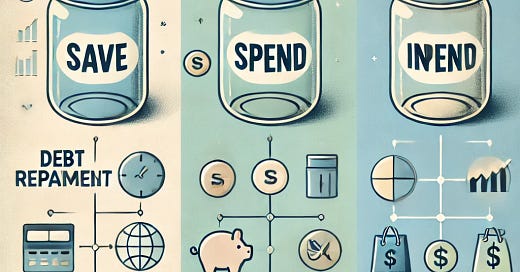Let’s face it—the word budget doesn’t exactly spark joy. For many, it conjures up images of restrictive spreadsheets, endless calculations, and the dreaded "cutting back" on everything fun. But what if I told you there’s a simpler way to take control of your finances?
Enter the anti-budget—a refreshingly straightforward approach that ditches the rigidity of traditional budgeting and focuses on what really matters: paying yourself first and enjoying guilt-free spending.
Step 1: Embrace the Core Principle—Pay Yourself First
The cornerstone of the anti-budget is prioritizing saving and investing. Here’s how it works:
Decide on a Savings Percentage
Pick a percentage of your income to save or invest each month. Whether it’s 10%, 20%, or more, make it automatic. The idea is to treat this savings as a non-negotiable expense, like rent or your utility bills.Automate Your Savings
Set up automatic transfers to your savings account, retirement fund, or investment account. This removes the temptation to spend the money and ensures you’re always saving without even thinking about it.Forget About It
Once your savings are handled, you can use the remaining money however you want—without guilt.
This “pay yourself first” mentality builds financial security without the need for tracking every latte or movie ticket.
Step 2: Understand Your Spending Patterns
Unlike traditional budgeting, the anti-budget doesn’t ask you to micromanage every dollar. Instead, it focuses on awareness.
Use Tools, Not Spreadsheets
Budgeting apps like Mint or PocketGuard, or simply reviewing your bank statements, can show you where your money goes. The goal isn’t to judge yourself but to identify trends.Spot the Leaks
Are there areas where you’re overspending without realizing it? Maybe it’s subscription services you don’t use or frequent takeout orders. Awareness empowers you to adjust if needed—but only if you want to.
Step 3: Set Clear Financial Goals
Saving for the sake of saving can feel aimless. That’s why having concrete goals is a game-changer.
Define Your Goals
What are you saving for? A home, early retirement, a trip to Bali? Write them down and give them a timeline.Visualize Your Progress
Use a savings tracker or app to watch your contributions grow. This can be incredibly motivating and makes the process feel rewarding.
Step 4: Relish the Flexibility
Here’s the beauty of the anti-budget: after you’ve paid yourself first, the rest is yours to spend however you like.
No Rigid Categories
Forget labeling every dollar. Once your savings are set aside, enjoy the freedom to spend spontaneously. Whether it’s a fancy dinner, a weekend trip, or an extra round of drinks, you can indulge without guilt.Make Adjustments Only When Necessary
If you notice you’re not saving enough for your goals, tweak the savings percentage. But otherwise? No spreadsheets. No stress.
The Anti-Budget Mindset: Prioritize Your Future Self
The anti-budget isn’t just a financial strategy—it’s a mindset shift. It’s about:
Building Financial Security
By saving consistently, you’re setting yourself up for long-term stability and opportunities.Enjoying the Present
You’re giving yourself permission to spend freely on what matters to you now.Finding Balance
It’s about achieving financial freedom without the sacrifice of traditional budgets.
Is the Anti-Budget Right for You?
The anti-budget works well for those who value simplicity, dislike detailed budgeting, or want more flexibility in their financial life. However, it may not be ideal if you’re currently struggling to control your spending or need stricter discipline to meet your goals.
The Takeaway
The anti-budget offers a refreshingly simple approach to managing money. It shifts the focus to saving and investing first while allowing you to spend the rest with zero guilt. No complicated formulas, no rigid categories—just a straightforward way to prioritize your future and enjoy your life now.
Ready to give it a shot? Set a savings goal, automate your contributions, and let the anti-budget work its magic!
Additional Resources for Getting Started
YNAB (You Need a Budget): A budgeting app that aligns with various spending styles.
Mint: A free app to track spending and identify patterns.
Atomic Habits by James Clear: A fantastic book for building lasting habits (like automating savings).
Take control of your finances—no spreadsheets required!





